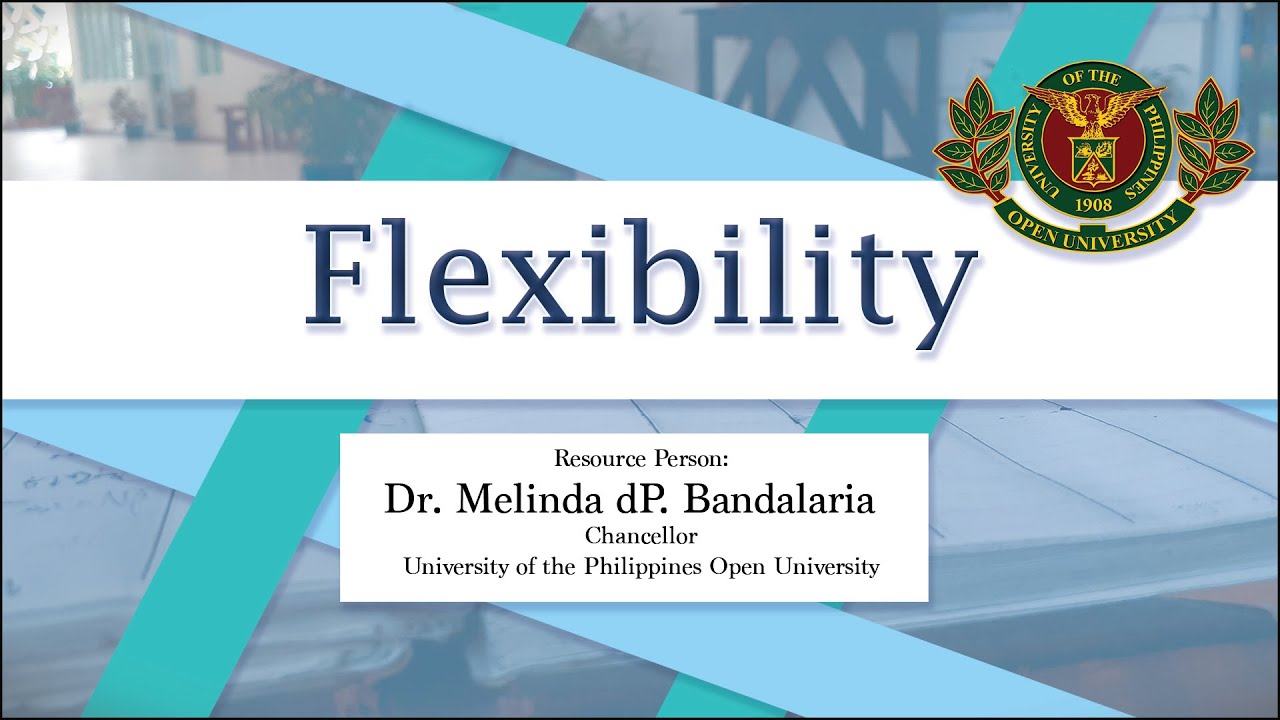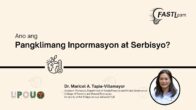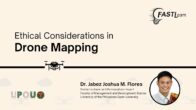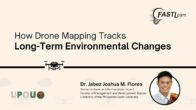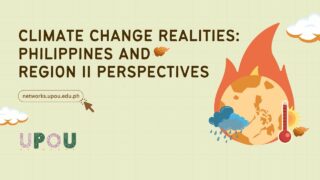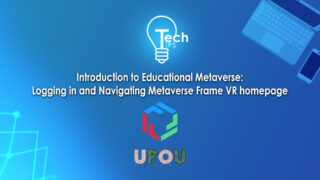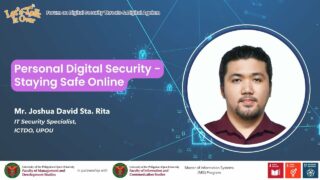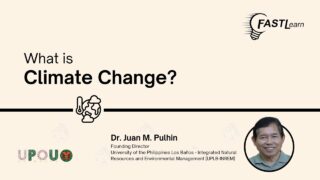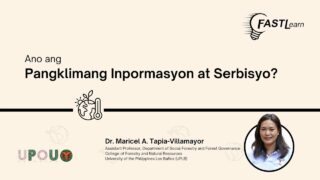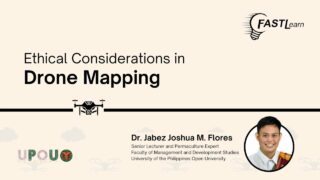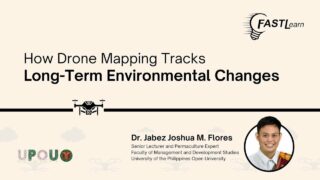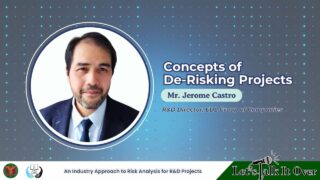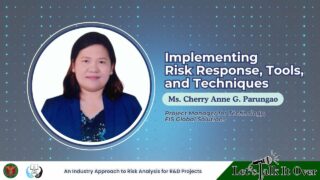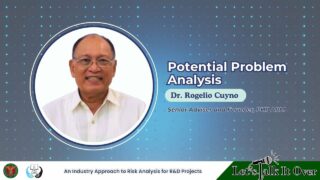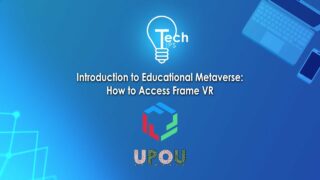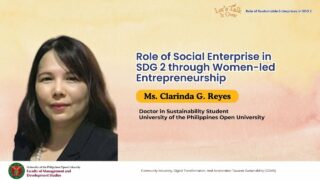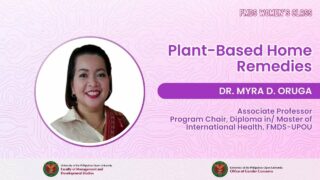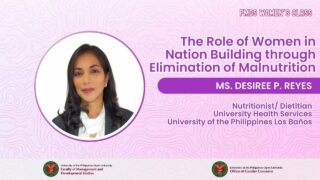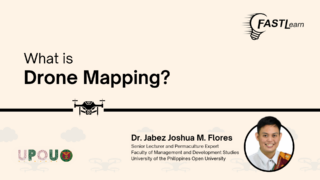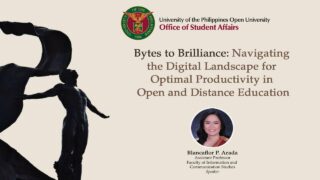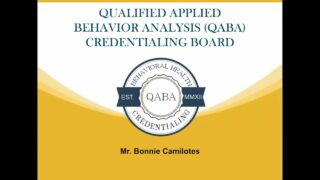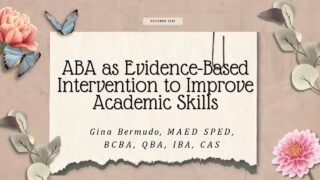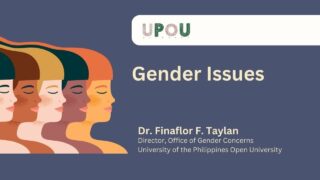Flexibility
Dr. Melinda dP. Bandalaria, Ph.D.
One of the affordances of modern information and communication technology or ICT is that it has provided us with so much flexibilities on how we do things. Today, we have the option to connect with families and friends through social media. We don’t have to be with them physically to be updated on what is happening with them, or even to celebrate special occasions with them. We can opt to be virtually celebrating with them at the moment it is happening or be updated with what had happened after the event.
Another familiar example of how ICT provided us with flexibility is in shopping. Some of us find enjoyment in going to the malls and window-shop before we get to choose the items to buy. But there are also those who may want to avoid the traffic or simply do not have the time to go to the mall to shop. Further, there are those items which can only be bought online, especially if they are not available in the
local market. Online shopping is a big business because of these reasons. The affordances of modern ICT had provided the same or even more flexibilities in the way we teach and learn today. Educational institutions can opt to offer their courses and degree programs in technology-enhanced, blended, or fully online mode to also accommodate the changing profile and circumstances of today’s learners.
I will be discussing about how modern ICT has provided flexibilities to learning, taking off from my experience as a teacher in open distance e-learning mode of instructional delivery. It is important for teachers to have this understanding, so we can design our teaching to accommodate possible context and scenarios. To have a common grounding of our discussion, let’s take a look at the definition of the word “flexibility”. Searching the internet, one can find many definitions of the word “flexibility”. One definition appropriate for our discussion is “capable of being changed or adjusted to meet particular or varied needs”. We are aware that learning can happen or should happen under different circumstances and contexts. We have seen these different contexts in our classmates and most likely have experienced them ourselves.
Fortunately for us, modern ICTs have offered many flexibilities in the way one can learn, especially in the important ingredients or components to building knowledge and learning. These are communication, collaboration, and interaction.
Let’s take a closer look at these three concepts.
Communication is defined as a “two-way process of reaching mutual understanding, in which participants not only exchange information, news, ideas, and feelings, but also create and share meaning”.
Collaboration as an educational approach involves groups of learners working together to solve a problem, complete a task, or create a product, which in most cases, are requirements in the course where the students are enrolled. It is based on the idea that learning is a naturally social act. And while communication and interaction result in interaction with teachers and fellow learners, there are two more types of interaction that I want to highlight: learner-content interaction, and learner-community of practice interaction.
We all know that communication is essential to the teaching and learning process, and it can happen online or offline. We are familiar with classroom or face-to-face settings where students and teacher are communicating or talking to one another. It is also usual to see announcements in university premises or even in classrooms. And nowadays, it is common for teachers and students to be communicating through email, skype, discussion forums, and social media. These examples imply a real time interaction or a time lapse between the sending and response in communication, collaboration, and interaction, and hence can fall under two major classifications—asynchronous and synchronous. These terms again, imply the time element where the learning processes take place.
Synchronous means real time or working together simultaneously. While asynchronous implies a time lag in the interaction. Asynchronous learning can be carried out in both online and offline environments. In an offline context, where both teachers and students are not connected to the internet or do not have access to the internet, the following are the possibilities: in an asynchronous and offline situation, we can think of posters, written notes, board announcements as mode of communication and collaboration, and also learner-learner and learner-teacher interactions. Learner-content interaction under this setting is through reading of physical books and printed lecture notes.
For learner community practice interaction, I can only think of posters in community announcement boards. With [the internet], there are many options or flexibilities to carry out the learning events, even asynchronously. Asynchronous online is one of the major features of open distance e-learning where learners and students are geographically separated from each other, but maximize the affordances of modern ICTs to connect to one another and go through the learning process. Course content is delivered through the web or through a learning management system, and students access them at their most convenient time and schedule.
Communication, collaboration, and interaction or connecting to one another are facilitated through various technology tools like email, discussion forums, and social media posts.
Collaboration and connectivism among learners can be done through open access tools like project Wiki, google drive, podio, TitanPad, Show Document and also Discussion forums. Learner-content interaction is enriched and is afforded more time to reading digital resources, watching videos from online repositories like YouTube, or sent via email, or posted [on] social media sites.
Online communities of practice and websites are tools for learner-community of practice interaction. In an asynchronous setting, students have plenty of time to formulate thoughts, and respond in detail to a question or topic that they might have answered incompletely in a real time conversation. This time log in communication helps students internalize information by giving them time to research certain ideas or merely extra time for contemplation.
Now, let’s take a look at synchronous learning. As I had mentioned earlier, synchronous means real time or happening simultaneously, such that both the teachers and the students are engaged or participating in the learning activity at the same time. The usual asynchronous and offline learning event happens in classroom or face-to-face discussions. Under this context, we have face-to-face classroom discussions and chats, group meetings, experiments in laboratories, field trips, to facilitate communication and group work among students.
For synchronous and offline learner-content interaction, we are familiar with students watching video materials together or listening to the teacher’s lecture in the classroom setting. Field trips and study tools are the usual examples of synchronous and offline Learner-Community of Practice Interaction.
Teaching and learning had been revolutionized by modern ICTs. We cannot settle with just the synchronous offline mode, even if we are in the residential instruction. Even in the conventional mode, the teaching and learning environment can be enriched through the integration of synchronous and online tools.
For communication/collaboration, learner-learner and learner-teacher interactions, we have the online chat, instant messaging, teleconferencing using various tools like Google Hangout, Skype, and Facebook Live, as examples of technology tools.
For Learner-Content Interaction as well as Learner-Community of Practice interaction we can have online lectures, webinars, videoconferencing, and also online chats. Tools like instant messaging allow students to ask questions on topics that are not clear to them and be able to get their teachers’ answer immediately. Teachers, on the other hand, can immediately gauge based on nonverbal cues, whether further clarification is needed on specific topic or even verbalize or affirm it by asking students the relevant questions.
Learning from synchronous communication is believed to be enhanced because real time conversations allow people to think about the concept or, verbalize or explain it, and even connect their own thoughts with the interpretations and explanations of their fellow learners. The current trend of opening access to education also made possible other models of flexibilities which can be explored to further enrich the Learner-Learner Interaction and Learner-Content Interaction. And this is through the Massive Open Online Courses or MOOCs.
Consider this: as of 2016, there are more than 4, 000 courses being offered. Tapping in terms of the number of courses are business and management, which accounts for 16.8 % of the total courses offered. Science accounts for 11.3 % and Social Sciences, 10.8 %. These numbers implied that there can be courses which are part of the usual subject assigned to us to teach or we can combine MOOCs to complete the whole course that we are teaching. These MOOCs also offer flexibilities to maximize Learner-Learner, Learner-Content and Learner- Community of Practice Interactions in an online learning environment, both synchronously or asynchronously.
Any of the following models or their combinations and variance can be explored or
considered.
The first model is the simplest, as if it’s just similar to using MOOCs as OERs, that is [getting] materials from MOOCs to enrich the learning materials of our students. The other three models entail enrolling students in MOOCs, have discussions in class like a modified flip classroom, where class meetings are used for tutorials or teacher guided discussions, or enroll students in MOOCs and develop a separate assessment mechanism like assignments, portfolio of course requirements, quizzes and exams.
The last model is enrolling students in MOOCs and [validating] the achievement of
the learning objectives through a one-time assessment.
Let’s now take a look at the other possibilities and flexibilities in learning afforded
by the modern ICTs. First, in Learning Resources. Learning resources are available in various formats and containers or repositories. Hence, we can talk of analog resources or digital resources which are available online or offline or both. The flexibility, that each of these formats can provide learners, varies like there is a limit on how and where we can access analog materials like books and posters. In the same manner, there is a higher level of flexibility offered by digital material since they can be made available both in the online mode and offline mode.
Digital learning resources can be made available in CDs or thumb drives, and can be made accessible to the learners anytime, even without access to the internet. Of course, we are also familiar with analog resources being digitized, like uploading scanned copies of materials and sharing them digitally, or digital resources converted to analog format by printing them. Again, these mechanisms provide flexibilities to teachers and learners in terms of accessing, sharing, and using learning resources.
Focusing on modern ICTs, there are two models by which teachers can provide learners with flexibility on the use of materials available on the web. Model one is we use credible resources [from] the web to enrich our teaching materials with multimedia format of learning objects instead of just us talking and lecturing to them the lesson. Examples of this are: first we prepare our lesson for the day and get resources from the web for any one or combination of the following instructional activities. You can use the materials from the internet to draw interest of your students to the lesson for the day. This can be in the format of video materials which can also help in scaffolding or connecting learners with prior knowledge to the lesson to be discussed.
The other methodology or mechanism is use the materials as the lesson proper. Again, it can be in the form of video or powerpoint presentation. Other mechanism is used the materials for assessment, either formative or summative assessment.
Materials from the internet can be used as case studies, which teachers can use in aid of learning or to assess learning. Take note that teachers should not limit themselves to materials that are already in the internet. Teachers can also opt to develop their own materials and upload them to the internet where students can access them or share them with their students through email or other platforms. Of course, it is important that in this mechanism, we also direct the learners to the original materials or text written by the authors.
The second mechanism is by allowing our students to search the materials themselves on specific topic or lesson and in the process, make them read the original texts, and analyze the various perspectives that the authors present and represent through their works. In the process, we also developed in them critical perspective or thinking, and even multimedia literacy, which is an important skill to learn in the 21st century. Take note that in terms of learning resources, one aspect that should be considered is the available open educational resources or OERs. These are open access materials usefully license under creative commons, and which the user can copy, distribute, edit, remix and build upon.
We are now talking about CC or Creative Commons 2.0 and CC or Creative Commons 3.0. Under these versions, one is free to share; that is copy and they distribute the material in any medium or format and adapt; that is the remixed, transform and build upon the materials for any purpose even commercially, as long as attribution is properly observed.
Attribution means you must give appropriate credit or provide a link to the license and indicate if changes were made. You may do so in any reasonable manner, but not in anyway that suggests that the licensor endorses you or your use of that material.
There is a challenge, however, in selecting materials from the internet, given the amount of information and data that are now available, one would probably ask how big really is the internet or how much data is stored in the world wide web. No one can really provide an accurate measure at all. While there were many attempts of measuring the size of the internet using various methodologies, the agreement was that, what can be presented are just estimates, like, more than 300 hours of video uploaded every minute. In 2013, it was estimated that there were about four billion index web pages and that there were about 10 Yottabytes of data stored in there. If you may wonder, Yottabyte is the biggest unit of data measured to date, with one Yottabyte or YB equivalent to 1000 to the eighth power bytes.
Another flexibility is on the time to engage in learning activities. Modern ICTs, also empower learners to learn any time synchronously or asynchronously. Learning does not have to take place inside the classroom, and in real time, [and with the presence] of a teacher on a fixed schedule like 8-10 am, MWF.
The nature of the learning resources provided by the teacher can also provide flexibility and learning opportunities for the students. Students may opt to learn at night or early in the morning after a good night’s rest. Further, learning does not, and should not take into account, weekends or holidays, and the like. Learners can decide their best time to learn with the flexibility afforded by the modern ICTs.
Modern ICTs also provides flexibility in the place of learning. As I have mentioned, learning does not have to take place inside the classroom. Learning activities can be designed by the teachers such that face-to-face meeting inside the classroom can be maximized. Blended learning is one model which maximizes the use of modern ICTs and also draw on the benefits of face-to-face meetings. Under blended learning, part of the students learning is done outside the classroom or in distance education mode of delivery or independent mode. And part of the course time is done in the classroom under the supervision of the teacher. Take note though that the design of blended learning has pedagogical underpinnings and not done randomly. One common model of blended learning is the flipped classroom.
The flipped classroom is a pedagogical model in which the typical lecture and homework elements of a course are reversed. Short video lectures are viewed by students at home before the class session, while in class time is devoted to exercises projects or discussions. Lectures can be created by the instructor and posted online or selected from an online repository like an OER. As described by Edupost, the value of a flipped class is in the repurposing a class time into a workshop where students can inquire about lecture content, test their skills in applying knowledge, and interact with one another in hands-on activities. During class sessions instructors function as coaches or advisors, encouraging students in individual inquiry and collaborative effort.
Now let’s take a look at technology flexibility. Whether communication is synchronous or asynchronous, there is a wide range of technology or tools and software to choose from. The free access ones include Google Hangout, Skype—to a certain extent, Facebook Live, and some learning management systems which can provide teleconferencing or virtual conferencing facility like the BigBlueButton in the case of Moodle. Technology flexibility also implies that both students and teachers can choose the gadget to use when communicating or engaging in learning events. It can be mobile devices or tethered machines like desktop.
Options to present lessons in multimedia format is also a possibility with the various digital tools available. Learning can be achieved through multiple paths through the use of multimedia format like text, video, podcast, or even games and simulations. This also accommodates differently abled learners by making available provision for learning through bigger font size of text, or in podcast, and also provides space for different learning preferences and learning contexts.
Games and simulations also enable learners to participate in learning activities.
Modern ICTs also provide teachers with flexibility on assessment, especially if these are assessments in aid of learning.
As a summary, we can say that there are technologies which make possible ubiquitous teaching and learning—that is anytime, anywhere, in whatever or preferred or appropriate multimedia format and platform using whatever gadget and connection, and of course open to anyone.
Thank you.



